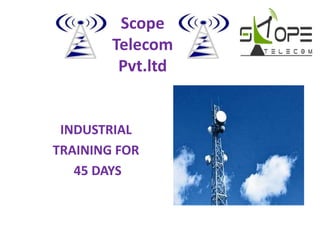Telecom Jobs in Chandigarh | Telecom Training in Chandigarh - Scope Telecom
- 2. HISTORY SCOPE Telecom Private Limited is a Telecom Company established in the year 2013.
- 3. Mission of Scope Telecom is To assist GSM operators for integration with continually growing technological trends and work more efficiently by providing globally qualified services.
- 4. INTRODUCTION A basic telecommunication system consist three primary units Transmitter that take information and converts it to a signal. Transmission medium is also called the physical channel that carries signal. Receiver that takes signal from from channel and convert it back to usable information.
- 5. But what’s cellular? HLR, VLR, AC, EIR MSC PSTN BS
- 6. 1st Generation • Start to use in 1989 • Call forwarding • All calls • No answer • Engaged • Unreachable • Outgoing calls barring • Incoming calls barring • Global roaming
- 7. drawbacks • Poor voice quality • Poor battery life • Large phone size • No security • Limited capacity
- 8. 2nd Generation • Finished process in 1995 • SMS(Short Message Services) • Multi Party Calling • Call holding • Call waiting • Mobile data service • Mobile fax service • Call line identity • Advice of charging • Cell broadcast
- 9. drawbacks • These system are unable to handle complex data such as videos
- 11. 2.5 generation • 2.5G is a technology between 2nd and 3rd generation, • Features • Phone calls • Send and receive email messages • Web browsing • Speed 64-144kbps • Camera phones • Take a time to 6 to 9 minutes to download a song
- 12. 3G GENERATION • 3G Generation introduce in year 2000 • Data transmission speed increase from 144kbps to 2mbps. • Typically called smart phones • Features • increase its bandwidth • Increase data transfer rate to accommodate audio and video files
- 13. GENERATION • Capable to provide speed 100mbps-1gbps • High security • Provide any kind of service at any time as per user requirement any where • battery uses is more • Hard to implement • Need complicated hardware • Expensive equipment
- 14. 4G GENERATION
- 15. GSM Architecture
- 16. GSM Overview
- 17. GSM Channels • Physical Channel: Each timeslot on a carrier is referred to as a physical channel • Logical Channel: Variety of information is transmitted between the MS and BTS. Different types of logical channels: – Traffic channel – Control Channel Downlink Uplink Channels
- 18. • BTS – houses the radio transceivers of the cell and handles the radio-link protocols with the mobile • BSC – manages radio resources (channel setup, handover) for one or more BTSs
- 19. • MSC – Mobile Switching Center • The central component of the network • Like a telephony switch plus everything for a mobile subscriber: registration, authentication, handovers, call routing, connection to fixed networks. • Each switch handles dozens of cells
- 20. • HLR – database of all users + current location. One per network • VLR – database of users + roamers in some geographic area. Caches the HLR • EIR – database of valid equipment • AuC – Database of users’ secret keys





















